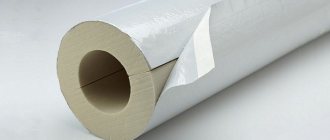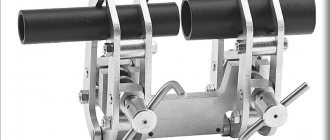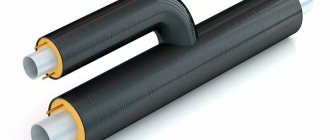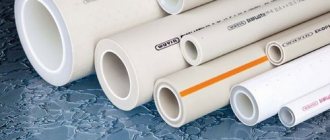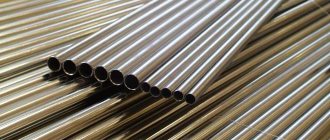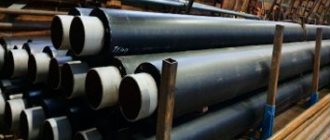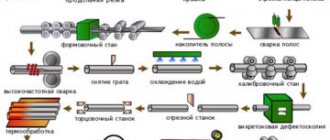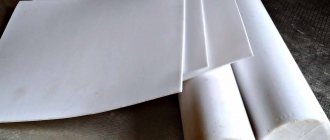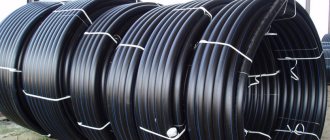The PPU shell is a semi-rigid (rigid) cylindrical product made of low-density polyurethane foam, which provides insulation, and, more precisely, thermal insulation of various pipelines. Such insulation is considered the most effective for pipes with coolant or products of the petrochemical industry. Technical parameters of the state of channels with PPU insulation are continuously monitored by the UEC (operational remote monitoring) system.
The so-called “shell” made of polyurethane foam is used for thermal insulation of pipelines for various purposes.
Design features of the insulating polyurethane foam shell
Structurally, polyurethane foam shells are half-cylinders one meter long, the internal diameter of which corresponds to a similar parameter of the insulated pipelines.
Note! To facilitate installation work, the products are equipped with locking longitudinal and transverse elements, which ensure the tightest possible connection.
The density of polyurethane foam is approximately 60 kg/m3, which greatly simplifies the assembly and transportation of shells for pipe insulation. Such thermal insulation is attached using glue or foam, as well as iron ties. To insulate a pipeline with a bend, corner elements are used.
For the production of heat-insulating polyurethane foam polyurethane foam shells for pipes, molds are used. Depending on the operating conditions, such products can be manufactured with an auxiliary coating of galvanized steel, aluminum foil, mastic, reinforced foil or fiberglass. Such protective layers increase the characteristics of deformation and mechanical strength, and also increase the service life of the insulation shell.
The shell has a rigid structure and consists of two parts for ease of installation
Types of polyurethane foam shells
The standard shell configuration is a hollow cylinder (or semi-cylindrical segments) of polyurethane foam without any additional coating.
Such products are most susceptible to mechanical stress, as well as moisture and UV rays, but they are excellent for use in ordinary household premises. External use is also permissible, but then the shell must be additionally wrapped, for example, with aluminum foil.
To ensure protective properties, additional layers are applied to the basic equipment:
- foil paper improves waterproofing properties, which allows the shell to be used in conditions of high humidity;
- armofol protects against UV radiation and further reduces heat loss;
- galvanized steel increases resistance to mechanical stress and also protects from sunlight and precipitation.
- fiberglass combines all the protective properties, and also practically does not weigh down the shell.
Note! In high-quality products, the protective layers are tightly sealed to the polyurethane foam base and cannot be separated from each other without effort and additional tools.
Main product dimensions
The characteristics and dimensions of heat-insulating polyurethane foam shells for pipes are presented in the technical specifications (5758-019-01297858-01) for the products. According to the document, the internal diameter of products can be: 142.0; 122.0; 102.0; 92.0; 82.0; 72.0; 63.0; 53.0; 42.6; 32.5; 27.3; 21.9; 15.9; 13.3; 10.8; 8.9; 7.6 and 5.7 centimeters. The length of the heat-insulating polyurethane foam shell varies from 100 to 200 cm, but it can be changed by agreement with the customer.
The thickness of the product must be equal to the same parameter of the insulated layer of pipes and is selected from the table.
Table 1
| External section of steel pipes, cm | Thickness of shell-insulation for pipes, mm |
| 5,7 | 38,5 |
| 7,6 | 39,0 |
| 8,9 | 42,5 |
| 10,8 | 43,0 |
| 13,3 | 54,5 |
| 15,9 | 38,6 |
| 21,9 | 43,1 |
| 24,5 | 49,4 |
| 27,3 | 57,2 |
| 32,5 | 55,5 |
| 42,6 | 58,2 |
| 53,0 | 40,2 |
| 53,0 | 78,9 |
| 63,0 | 72,5 |
| 82,0 | 72,4 |
| 92,0 | 74,4 |
| 102,0 | 70,4 |
| 122,0 | 60-100 |
| 142,0 | 60-100 |
At the request of customers and design feasibility, the thickness of the thermal insulating shells of polyurethane foam can be changed.
Insulation can be made for both standard and non-standard size pipes
The radial angle of products with a diameter of 5.7-53.0 cm inclusive is 180 degrees; 63.0-82.0 cm inclusive – 120 degrees; for pipes with a cross section of more than 82.0 cm - 90 degrees. The geometric characteristics of polyurethane foam shells that heat-insulate pipelines may have deviations shown in the table.
table 2
| Name of geometric characteristic | Name of parameter deviation | Value of maximum deviations |
| Outside diameter | Deviation along the outer section of the shell, mm | +5 |
| Length | Length deviation, mm | ±10 |
Technical characteristics of polyurethane foam
Pipe shells are made from rigid CFC-free polyurethane foams. Their physical and chemical properties must be consistent with GOST 30732 of 2001 and the data in the table.
Table 3
| Indicator name | Unit | Meaning |
| Appearance | — | Fine-celled structure ranging in color from yellow to dark brown |
| Density, no less | kg/m3 | 60,0 |
| Tension at 10% deformation in compression, not less | kPa | 300 |
| Water absorption, no more | % by volume | 10,0 |
| Thermal conductivity at 20 degrees, no more | W/m*K | 0,035 |
| Thermal conductivity at 50 degrees, no more | W/m*K | 0,033 |
| Volume fraction of pores (closed), not less | % | 88 |
| Temperature of use, no more | ºС | 150 |
| Shear strength (axial direction), not less | MPa | 0.12 (at a temperature of 23±2 ºС) 0.08 (at a temperature of 140±2 ºС) |
| Shear strength (tangential direction), not less | MPa | 0.2 (at a temperature of 23±2 ºС) 0.13 (at a temperature of 140±2 ºС) |
| Thermal insulating radial creep at a test temperature of 140 ºС, no more | mm | 2.5 (for 100 hours) 4.6 (for 1000 hours) |
In many respects, polyurethane foam is more profitable than other materials for insulation. Its disadvantage is destruction under the influence of ultraviolet radiation. The approximate rate of destruction is 0.05 mm per year. Under the influence of the sun, the structure will begin to delaminate, peel and lose rigidity.
To prevent the destruction of polyurethane foam by ultraviolet radiation, the insulating layer is coated with polymer
The main advantages of PPU insulation
Polyurethane foam shells have a number of significant advantages, largely due to which they are superior to other insulating materials for pipes. Among them are:
- efficiency;
- resistance to rot, pests, and chemicals;
- possibility of use in a wide temperature range;
- fire safety;
- repeated use;
- environmental friendliness;
- minimizing the cost of repairing pipelines;
- ease and speed of installation.
If it is necessary to repair a certain section of PPU pipes, the insulation is carefully and easily removed, and upon completion of the work it is installed in its place. This significantly increases the speed and efficiency of the repair process. With PPU there are no difficulties in storage, transportation and loading/unloading.
Note! Under normal conditions, the moisture absorption coefficient of the material is 0.5. Only under pressure can polyurethane foam absorb moisture.
Light weight, easy-to-understand connection diagram and accessible fastening methods ensure high installation speed. The thermal insulation system can be installed by two workers on a pipeline with a length of up to 300 linear meters in 1 shift.
Installation of the shell does not require large expenses; the work can be easily completed by a small team of workers
How to install polyurethane foam shells
Installation of insulation is very simple and does not require special skills. First of all, you need to buy a shell that matches the diameter of the pipe that needs to be insulated (the d of the shell is 1-2 mm larger than the d of the pipe).
- For small-diameter pipes, one-piece shells with a side cut are produced.
- If the length of the pipe is less than 1 m (standard shell size), the excess length can be cut off with a regular construction or stationery knife.
- Through a cut on the PU foam product, the insulated pipe is placed inside the cylinder.
- The edges can be fastened with construction or super glue, secured with staples or a clamp, wrapped with thin wire and even tape (regular or double-sided). If a hermetic connection is required, special tapes and connecting locks are used.
- If the length of the pipe is more than 1 m, several pieces of shell are used, which are also fixed together at the joints.
- When working with a large diameter pipe, a polyurethane foam shell is used, consisting of several (usually two) segments.
- The segments are fixed using glue, clamps, wire, etc. There are also shells with a groove connection; such fastening is considered more reliable.
We recommend that you read: Do-it-yourself chimney for solid fuel boilers
Upon completion of installation, you can immediately begin operating the pipeline, unless time is required for the glue to dry.
Options for using polyurethane foam insulation
PPU shells for pipes with a diameter of 108 and 133 mm are used for thermal insulation of sewer pipes. Products with a cross section of 1.5; 2.0; 3.2; 4.5 and 5.7 cm usually serve as insulation elements for internal heating and water supply channels. PPU shell for pipes of elevator units and heating points usually has a diameter of 8.9; 10.8; 13.3; 15.9 and 21.9 cm. For main and process pipelines, products 27.3 are used; 32.6 and 102.0 cm.
Foil shells for thermal insulation of pipes are installed in enclosed spaces. This system is not suitable for use in heating mains with ducted or non-ducted installation. The PPU shell, covered with reinforced foil, can be mounted both inside and outside buildings. This foil reliably protects the insulating layer from precipitation.
Note! If the heat-insulating shell is covered with fiberglass or moisture-resistant plastic, then the system is applicable for all types of pipelines, especially for those laid directly into the ground.
Galvanized pipe insulation (PPU shell) is used mainly for open installations on regional and city highways, as well as oil and gas pipelines.
Technical parameters of other materials for insulation
In addition to polyurethane foam with UEC, pipes can be insulated with other materials. The table shows some technical parameters of such insulators in comparison with polyurethane foam.
Table 4
| Parameter | Coefficient of thermal conductivity | Duration of operation | Operating temperatures | Porosity structure | Density |
| Unit | W/m*K | Years | Degrees | — | kg/m3 |
| Hard polyurethane foam | 0,025 | 30-50 | -200 to +180 | Closed | 40-200 |
| Traffic jam plate | 0,050-0,060 | 3 | from -30 to +90 | Closed | 220-240 |
| Mineral wool | 0,052-0,058 | 5 | -40 to +120 | Open | 55-150 |
| Foam plastics | 0,040-0,050 | 5-7 | -50 to +110 | Closed | 30-60 |
| Foam concrete | 0,145-0,160 | 10 | -30 to +120 | Open | 250-400 |
Another fairly common material for insulation is expanded polystyrene (EPS). With the same shape and size, an insulation system made of polyurethane foam will have a higher density than one made of polypropylene foam. In other words, polyurethane foam is stronger than polystyrene foam.
Polystyrene foam insulation is inferior to polyurethane foam in strength
PPP is characterized by the following values of the main indicators:
- density: 25-50 kg/m3;
- thermal conductivity at 25 degrees: no more than 0.038-0.042 W/m*K;
- water absorption: no more than 1.0%;
- operating temperatures: -50-+75 ºС.
Expanded polystyrene can be used for all pipelines, except those carrying steam or superheated water.
Scope of application of polyurethane foam shell
PPU insulation replaces mineral wool products and is used for insulation:
- heating systems,
- hot and cold water supply,
- sewerage systems,
- housing and communal services pipes, heating mains, oil and gas industry pipelines, etc.
We recommend that you read: PVC pipes and their use for water supply installations - pros and cons
It is also possible to use it to protect electrical and fiber optic cables, insulate the interconnect line of split systems to avoid the formation of condensation, and so on.
Interesting! Due to the excellent thermal insulation properties of polyurethane foam, heat losses are 2-3% versus 20-30% when using mineral wool.
